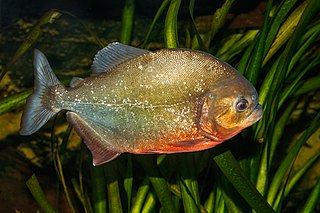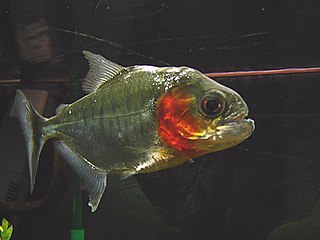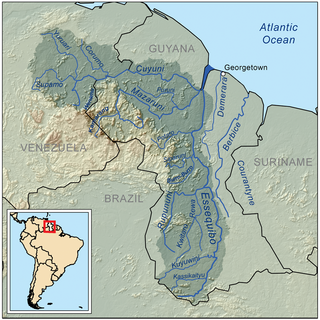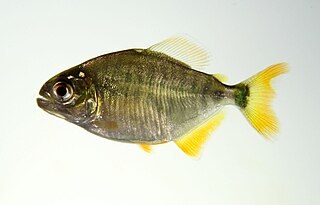
The Orinoco is one of the longest rivers in South America at 2,250 kilometres (1,400 mi). Its drainage basin, sometimes known as the Orinoquia, covers 989,000 km2 (382,000 sq mi), with 76.3 percent of it in Venezuela and the remainder in Colombia. It is the fourth largest river in the world by discharge volume of water. The Orinoco River and its tributaries are the major transportation system for eastern and interior Venezuela and the Llanos of Colombia. The environment and wildlife in the Orinoco's basin are extremely diverse.

A piranha or piraña, a member of family Serrasalmidae, or a member of the subfamily Serrasalminae within the tetra family, Characidae in order Characiformes. They are freshwater fish that inhabit South American rivers, floodplains, lakes and reservoirs. Although often described as extremely predatory and mainly feeding on fish, their dietary habits vary extensively, and they will also take plant material, leading to their classification as omnivorous.

The São Francisco River is a large river in Brazil. With a length of 2,914 kilometres (1,811 mi), it is the longest river that runs entirely in Brazilian territory, and the fourth longest in South America and overall in Brazil. It used to be known as the Opara by the indigenous people before colonisation, and is today also known as "Velho Chico".

Serrasalmus is a genus of piranhas. They are collectively known as pirambebas; the "typical" piranhas like the piraya piranha are nowadays placed in Pygocentrus. Like all piranhas, Serrasalmus are native to South America.

The Rupununi is a region in the south-west of Guyana, bordering the Brazilian Amazon. The Rupununi river, also known by the local indigenous peoples as Raponani, flows through the Rupununi region. The name Rupununi originates from the word rapon in the Makushi language, in which it means the black-bellied whistling duck found along the river.

The fish Pygocentrus piraya, often called the piraya piranha or San Francisco piranha, and sometimes sold as the man-eating piranha, is a large, aggressive piranha from the São Francisco River basin in Brazil.

Pseudoplatystoma is a genus of several South American catfish species of family Pimelodidae. The species are known by a number of different common names. They typically inhabit major rivers where they prefer the main channels and tend to stay at maximum depth, but some species can also be seen in lakes, flooded forests, and other freshwater habitats. They have robust bodies, and are important food fish. Recently, their population size has been on the drastic decline due to a variety of factors including overfishing and habitat destruction due to the construction of hydroelectric dams.

The Cetopsidae are a small family of catfishes, commonly called the whale catfishes.

The red-bellied piranha, also known as the red piranha, is a species of piranha native to South America, found in the Amazon, Paraguay, Paraná and Essequibo basins, as well as coastal rivers of northeastern Brazil. This fish is locally abundant in its freshwater habitat. They are omnivorous foragers and feed on insects, worms, crustaceans, and fish. They are not a migratory species but do travel to seek out conditions conducive to breeding and spawning during periods of increased rainfall. Red-bellied piranhas often travel in shoals as a predatory defense but rarely exhibit group hunting behavior. Acoustic communication is common and is sometimes exhibited along with aggressive behaviors. They are a popular aquarium fish.

Pristobrycon is a genus of piranhas from the Orinoco and Amazon Basins, as well as rivers in the Guianas.
Typhlobelus is a genus of pencil catfishes native to South America.
Palometa is a name used for several species of fish:
Sternarchogiton is a genus of weakly electric knifefish in the family Apteronotidae, with four known species, all living in the main channel of large rivers in the Amazon and Orinoco basins in South America.

Piaractus brachypomus, the pirapitinga, is a large species of pacu, a close relative of piranhas and silver dollars, in the serrasalmid family. It is native to the Amazon basin in tropical South America, but it formerly included populations in the Orinoco, which was described in 2019 as a separate species, P. orinoquensis. Additionally, P. brachypomus is widely farmed and has been introduced to other regions. In South Florida they are invasive in rivers, canals or lakes.
Pristobrycon careospinus is a species of serrasalmid endemic of Venezuela.
Pristobrycon maculipinnis, sometimes known as the marbled piranha, is a species of serrasalmid endemic to Venezuela.
Pristobrycon striolatus is a species of serrasalmid fish.

Pygocentrus cariba or black spot piranha is a species of piranha native to the Orinoco River basin lowlands and the Llanos region in Venezuela and Colombia. This species can reach a total length of 27.9 centimetres (11.0 in). It is popular as a game fish.

Pygopristis denticulata, or the Lobetoothed Piranha is a species of piranha. These fish are part of the group Ostariophysi, a large group of freshwater fish that includes minnows and catfishes. It is a rare South American fish found in the Orinoco River basin, north and eastern Guiana Shield rivers, and tributaries of the lower Amazon River. Piranhas typically live in freshwater, but other specimens can be found elsewhere. Specimens of this species is frequently found in acidic clear or black waters. Piranhas are primarily known for being savage, flesh-eating fish, but they actually have broader diets. They usually feed on aquatic insects, small fish, and fruits.
Pygocentrus palometa is a species of piranha native to South America, where restricted to the Orinoco Basin. Although recognized by FishBase, the scientific name may be a nomen dubium.












